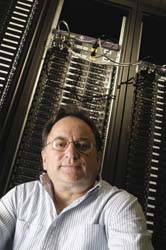Computer scientist spearheads $30 million ‘Open Science Grid’
University of Wisconsin–Madison computer scientists will play a central role in the expansion of a national “Open Science Grid” (OSG), an interconnected computing infrastructure that provides scientists with a massive infusion of computing power and storage capacity to solve large, data-intensive challenges in science.

Computer science Professor Miron Livny is principal investigator of a major new partnership between the National Science Foundation and the Department of Energy to create a national “Open Science Grid,” which will use distributed computing techniques to provide scientists with a massive infusion of computing power and storage capacity. The grid will harness the computational power of more than 30 participating universities and federal research laboratories. Livny’s pioneering efforts in distributed computing, including the Condor project, were influential in developing the five-year, $30 million project.
Photo: Michael Forster Rothbart
The National Science Foundation (NSF) and the Department of Energy’s (DOE) Office of Science announced today that they have joined forces to fund a five-year, $30 million program to operate and expand upon the two-year-old national grid. This project collectively taps into the power of thousands of processors distributed across more than 30 participating universities and federal research laboratories.
UW–Madison computer scientist Miron Livny, a pioneer in distributed computing, is principal investigator of the project and will be in charge of building and maintaining the facility and coordinating the software activities. Ruth Pordes of the Fermi National Accelerator Laboratory will serve as executive director of OSG and the two scientists will work in close partnership in managing the project.
“Grid computing has the capability to revolutionize research, but the tools remain challenging for many scientists,” Livny says. “Projects such as OSG are working to lower the barrier to individual scientists using advanced computing.”
Livny’s lead involvement reflects on the productive track record of two major distributed computing projects at UW–Madison. The Condor Project, in existence for more than 20 years, uses a network of more than 3,500 processors on the UW–Madison campus to support high-throughput computing challenges, putting supercomputing power in the hands of mainstream public and commercial users. The Grid Laboratory of Wisconsin (GLOW) is a campus-wide facility deployed to serve the Wisconsin scientific community, providing more than 30,000 computer hours a day to researchers in areas such as genome mapping, high-energy physics, cancer detection and treatment, and materials science.
Funding for the OSG project will be distributed across 11 U.S. universities and four national laboratories. In addition to administering the funds for the 11 universities, Livny’s team will receive $1.2 million per year for Madison-based OSG efforts.
Other universities involved in the consortium include: Boston, Columbia, Cornell and Indiana universities; the California Institute of Technology; and the universities of Florida, California-San Diego, Chicago, Iowa and North Carolina.
Federal research centers include Fermi, Brookhaven National Laboratory, Lawrence Berkeley National Laboratory and the Stanford Linear Accelerator Center.
Each member of the OSG consortium is supplying computing power to the shared facility, which runs the gamut from small clusters of computers to thousands of networked processors. Some of the OSG sites offer petabytes (1,000 terabytes) of data storage. That level of power is especially useful for large-scale science in particle physics and genomics.
Distributed computing has been one way to capitalize on the massive increase in the power and performance of commodity hardware. It has led to the equivalent of supercomputing power, in Livny’s words, “resting on office desks, piled on laboratory shelves, or mounted on racks in machine rooms.”
The development will have major benefits for Wisconsin scientists, Livny adds. “Now that GLOW is interfaced with the Open Science Grid, local scientists will easily be able to tap into the power of this national resource.”
The OSG leadership should have other benefits locally, Livny adds. This summer, UW–Madison’s College of Letters and Sciences established a campus Center for High-Throughput Computing, which will provide greater staff support for OSG, Condor and GLOW. These three research areas will offer greater research potential for any UW–Madison research team that has demanding computational needs and enable the computer science department to maintain leadership in distributed computing.
In recent years, GLOW projects have included not only physicists and molecular biologists, but economists working to simulate the effect of school vouchers in the nation’s 20 largest cities.
“The Open Science Grid will take high-throughput computing to the next level,” Livny says.




